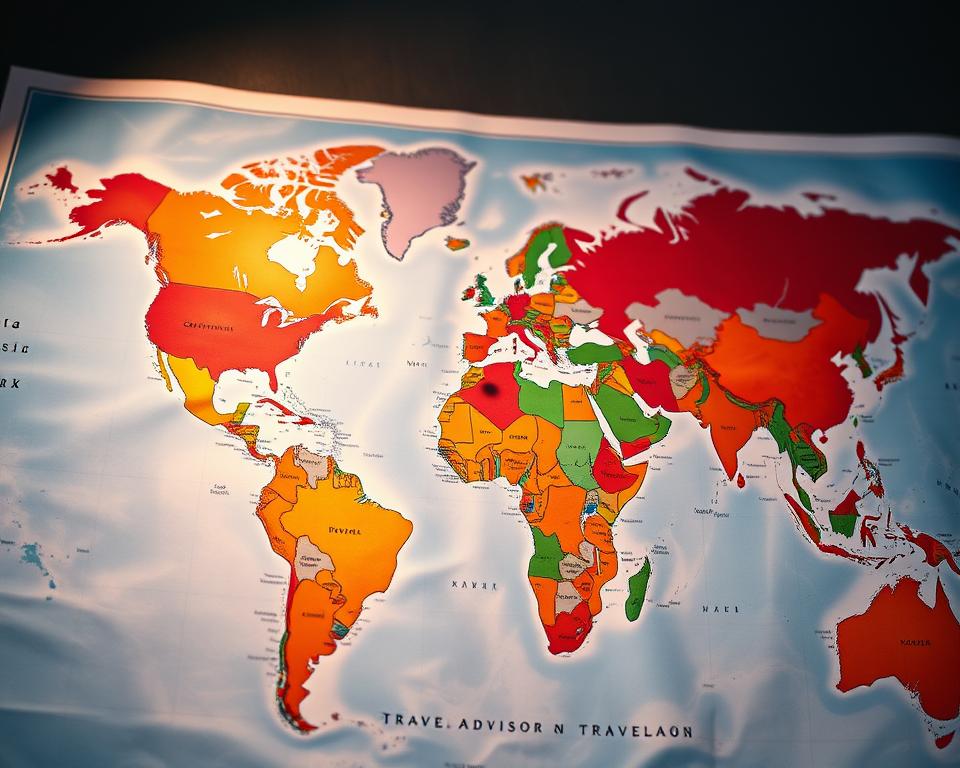
Up-to-Date America Travel Advisory Map
Did you know that nearly 80% of US travelers are unaware of the potential safety risks in their destination? This startling statistic highlights the critical importance of staying informed while traveling. The America Travel Advisory Map serves as a vital resource for understanding travel safety across the United States and beyond. This comprehensive guide offers insights into destination risks, current travel alerts, and essential tips for maintaining security during your travels. By utilizing this map, travelers can better plan their itineraries while being aware of any potential risks or safety concerns.
Key Takeaways
- The America Travel Advisory Map provides essential travel safety alerts.
- Staying informed helps mitigate risks associated with travel.
- Understanding your destination’s advisory level enhances overall vacation security.
- Current alerts can change frequently, impacting your travel plans.
- Utilizing the map can lead to safer, more enjoyable travel experiences.
Understanding the Importance of Travel Advisory Maps
Travel advisory maps serve as vital tools for anyone planning a journey. These maps compile comprehensive information regarding potential safety threats, allowing travelers to evaluate the security of their destination. By highlighting areas with regional conflicts, health crises, or environmental hazards, these maps play a crucial role in enabling informed travel choices.
The significance of travel advisory maps is unparalleled when it comes to travel risk management. They equip individuals with the insights necessary to understand their surroundings and prepare for unforeseen circumstances. Assessing the risks associated with a destination is essential not just for health and safety, but for peace of mind as well.
Engaging with travel advisory maps fosters effective destination risk assessment. Travelers can analyze various factors that impact safety, such as crime rates and natural disasters, which ultimately leads to a more secure travel experience. Knowledge is power, and with these maps, individuals can embark on their adventures armed with pertinent information.
What is an America Travel Advisory Map?
An America Travel Advisory Map is a valuable tool designed to provide travelers with crucial visual information about the safety levels of various destinations. The State Department produces this map, ensuring that it reflects the most current data related to travel safety alerts.
The map categorizes regions based on various factors, including crime rates, health advisories, and potential natural disasters. This focused approach allows tourists to easily assess the safety concerns associated with their travel plans.
Understanding the America travel advisory map involves recognizing the color-coded levels of risk. These levels range from safe travel conditions to warnings about severe risks, helping individuals make informed decisions before embarking on their journeys.

How to Read the America Travel Advisory Map
Reading the america travel advisory map is essential for every traveler. This map employs a coding system featuring various colors and symbols that correspond to specific advisory levels. Understanding these levels will enable you to make informed decisions about your travel plans regarding safety and security. Filled with information, the map categorizes advisory levels from “Exercise Normal Precautions” to “Do Not Travel.”
To better understand the meanings behind the colors and symbols on the map, here is a brief overview of the US travel advisory levels:
| Advisory Level | Description |
|---|---|
| Level 1: Exercise Normal Precautions | This indicates that travelers should plan ahead and remain cautious. |
| Level 2: Exercise Increased Caution | This suggests being aware of surroundings and staying informed about local situations. |
| Level 3: Reconsider Travel | Travelers are advised to carefully weigh the need for travel against possible risks. |
| Level 4: Do Not Travel | This level warns against all travel to certain areas due to serious risks. |
Staying updated with travel warning updates is crucial. By regularly consulting the america travel advisory map, travelers can adapt plans based on current safety assessments. It’s important to familiarize yourself with accompanying guidelines specific to each advisory level issued by governmental agencies. This knowledge provides clarity and supports safer travel experiences.

Travel Safety Alerts: What You Need to Know
Travel safety alerts serve as essential notifications issued by government authorities, aimed at informing travelers of potential risks associated with specific destinations. These alerts encompass a wide range of issues, including political unrest, health crises, and natural disasters. Staying informed about travel safety alerts can significantly enhance a traveler’s ability to assess destination risks effectively.
When situations arise that could impact travel, timely updates are crucial. Recent travel warning updates provide details on ongoing events, enabling individuals to make informed decisions. These updates can highlight areas experiencing tumultuous conditions or health risks, offering context and clarity that aid in a comprehensive destination risk assessment.
Understanding the nature of these alerts empowers travelers to plan better and ensure their safety. By regularly checking for updates, one can avoid unnecessary risks while traveling. Remember, being informed equips you with the knowledge to navigate potential hazards effectively, ensuring a safer journey overall.

Destination Risk Assessment for Your Trip
A destination risk assessment is crucial before embarking on any travel adventure. This assessment examines various potential risks that may arise during your trip. By considering factors such as local health situations, political climates, and natural hazards, travelers can make informed decisions that promote safety and enjoyment.
Utilizing travel safety alerts plays a vital role in this assessment. These alerts provide essential updates regarding current conditions at your destination, enabling you to understand any pressing concerns. With this information, you can easily identify areas of caution, which will guide you in travel risk management.
Implementing effective travel risk management strategies promotes peace of mind. Identify risks through thorough research, monitor travel safety alerts, and take proactive measures to mitigate potential threats. Proper planning ensures that you are well-prepared and can navigate your journey with confidence.
As you prepare for your next trip, remember that a comprehensive destination risk assessment enhances your ability to explore new locations while keeping safety at the forefront. Being informed and prepared allows you to experience your travels to the fullest.
| Risk Type | Description | Mitigation Strategy |
|---|---|---|
| Health Risks | Potential outbreaks or illnesses. | Stay updated with health advisories and vaccines. |
| Safety Risks | Crime rates and local unrest. | Research local laws and travel alerts. |
| Natural Hazards | Floods, earthquakes, or other environmental concerns. | Monitor local weather and geological reports. |
| Transportation Risks | Accidents or unreliable transport systems. | Choose reputable transportation providers. |
Travel Warning Updates: Staying Informed
Staying informed about travel warning updates is essential for anyone planning a trip. The State Department travel alerts play a crucial role in keeping travelers aware of changing safety conditions across various regions. These alerts provide important details about potential risks, such as political unrest, natural disasters, or health emergencies.
Travelers can easily access this vital information by regularly checking the America travel advisory map. This resource allows individuals to visualize the risks associated with specific destinations, helping them to make informed choices. Before embarking on your journey, it is wise to review the latest alerts and advisories to ensure a safe travel experience.
Vacation Security Tips for a Worry-Free Journey
When embarking on a journey, following effective vacation security tips can enhance both your safety and enjoyment. Situational awareness should be your priority. Always remain aware of your surroundings and trust your instincts, as this can help you avoid potentially dangerous situations.
Securing your valuables is crucial. Use hotel safes, even for small items like passports and electronics. Keeping your belongings close will reduce the risk of theft. Additionally, limit the amount of cash you carry; consider using a travel card for easy access to funds while minimizing loss exposure.
Staying informed about local risks should be part of your travel plans. Utilize travel safety alerts to keep up with the latest news about your destination. This real-time information can guide your decisions and help you avoid areas known for safety concerns.
Having a list of emergency contacts is also a wise safety measure. Include local emergency numbers, friends or family back home, and your country’s embassy or consulate. In case of unexpected issues, knowing whom to contact can ease the situation.
| Vacation Security Tips | Description |
|---|---|
| Keep Valuables Secure | Utilize hotel safes and carry minimal cash. |
| Stay Informed | Consult travel safety alerts regularly during your trip. |
| Document Emergency Contacts | Have local emergency numbers and embassy contacts readily available. |
| Trust Your Instincts | Remain aware of surroundings and avoid risky situations. |
Implementing these vacation security tips can significantly enhance your travel risk management strategy. Prioritizing your safety not only allows for a more enjoyable experience but also provides peace of mind as you explore new destinations.
The Role of Travel Risk Management in Planning
When preparing for a journey, understanding travel risk management is essential. This approach involves evaluating potential threats and taking precautions to safeguard yourself. Utilizing tools like the America Travel Advisory Map serves as a reliable resource for assessing travel safety alerts that could impact your plans.
A key component of travel risk management is conducting a thorough destination risk assessment. This assessment identifies factors such as health risks, local security conditions, and natural disasters in the areas you plan to visit. By being informed, you can create a more resilient travel itinerary.
Implementing effective travel risk management strategies not only enhances safety but can also significantly improve your travel experience. Knowledge of travel safety alerts allows you to adapt your plans if needed, ensuring that your trip remains enjoyable and stress-free.
| Risk Factor | Impact Level | Mitigation Strategy |
|---|---|---|
| Health Alerts | High | Stay updated on health advisories and consider vaccinations |
| Crime Rates | Medium | Research crime trends in the area and avoid high-risk neighborhoods |
| Natural Disasters | Varies | Monitor weather forecasts and have an emergency plan |
Understanding US Travel Advisory Levels
The US travel advisory levels categorize destination safety into five distinct tiers, from Level 1 (Exercise Normal Precautions) to Level 4 (Do Not Travel). Each level conveys crucial information about the potential risks travelers may encounter. Knowing these levels helps individuals make informed decisions when planning trips.
Travel warning updates can change quickly, reflecting current conditions in various locations. Travelers must remain vigilant and check regularly for any updates. State department travel alerts provide essential notifications about safety concerns, health risks, and other factors that could affect travel.
When picking your next destination, consider the US travel advisory levels as an initial gauge of safety. This systematic approach to categorizing risk not only promotes informed travel but also enhances overall awareness for those planning journeys abroad.
State Department Travel Alerts: Keeping You Updated
The state department travel alerts play a crucial role in informing travelers about potential risks while abroad. These alerts encompass health threats, civil unrest, and other safety concerns that may arise during your travels. By staying informed through regular checks of the america travel advisory map, you can be better prepared for any unexpected situations.
Travel safety alerts provide details regarding specific countries and regions, offering vital insights for your trip planning. This ensures that you can make educated decisions based on the most current information available. Ignoring these alerts may lead to unfavorable situations that could have been avoided with proper preparation.
Utilizing the state department travel alerts in conjunction with the america travel advisory map enhances your travel experience and overall safety. Being proactive about your travel health and security is essential in today’s ever-changing environment. Keeping an eye on these alerts not only boosts your safety but also provides peace of mind as you explore new destinations.
How to Use the America Travel Advisory Map Effectively
Utilizing the america travel advisory map can make a significant difference in your travel preparations. Start by understanding the color codes that represent different advisory levels. This visual guide offers insights into potential risks associated with specific regions. By cross-referencing the map with travel safety alerts and other local information, travelers can gain a comprehensive view of their destination.
Incorporating the america travel advisory map into your travel planning contributes to effective travel risk management. For instance, travelers may find valuable travel warning updates that highlight specific dangers or issues in particular areas. Being informed empowers you to make better decisions about your itinerary and overall safety.
Taking the time to familiarize yourself with the layout and available updates on the america travel advisory map can enhance the overall travel experience. Being proactive ensures a safer and more enjoyable journey.
Regional Overview: South America Travel Advisories
Travelers heading to South America should stay informed about the various South America travel advisories that pertain to different regions. Each country presents its own safety landscape, which requires careful consideration during planning.
For instance, countries like Chile and Uruguay commonly receive lower advisories due to their stable political environments and lower crime rates. In contrast, areas such as Venezuela and some parts of Colombia exhibit higher risks, with travel safety alerts highlighting concerns such as civil unrest and violent crime.
Understanding these conditions allows visitors to conduct an accurate destination risk assessment. Keeping abreast of the latest updates ensures that travelers can make well-informed choices about their itineraries and precautions.
| Country | Travel Advisory Level | Key Safety Concerns |
|---|---|---|
| Chile | Low | Petty crime, tourist scams |
| Uruguay | Low | Minimal threats |
| Argentina | Moderate | Crime in urban areas |
| Colombia | High | Violent crime, civil unrest |
| Venezuela | Critical | Severe crime, political instability |
By staying aware of the recent travel safety alerts and adhering to these travel advisories, individuals can significantly enhance their safety while exploring the vibrant cultures and landscapes of South America.
Exploring the Travel Advisories for North America
Travel advisories for North America provide essential information that varies across countries and regions. Understanding the North America travel advisories helps travelers make informed decisions based on the specific risks associated with their destinations. Each country within this region may present different challenges, indicating the importance of checking the latest updates.
Staying up to date with travel safety alerts can significantly enhance your travel experience. Alerts may range from natural disasters to civil unrest or health crises, all of which can impact your itinerary. Being aware of these factors fosters preparedness and can help avoid potential pitfalls during travel.
Travelers should familiarize themselves with the different US travel advisory levels that classify the safety of various locations. This system offers a clear understanding of the risks, making it easier to assess whether to proceed with travel plans or reconsider certain locations altogether. By actively monitoring these advisories, individuals can maintain a higher level of safety while exploring North America.
Popular Destinations and Their Advisory Levels
Understanding the advisory levels for popular destinations is vital for ensuring a safe travel experience. With growing concerns regarding safety in various regions, staying informed about advisory levels helps travelers plan appropriately. Here is a brief overview of some well-known locations along with their current advisory levels:
| Destination | Advisory Level | Travel Warning Updates |
|---|---|---|
| Mexico | 2 (Exercise Increased Caution) | Recent incidents in tourist areas; travelers should remain vigilant. |
| Italy | 1 (Exercise Normal Precautions) | Stable conditions, watch for updates on local events. |
| Thailand | 2 (Exercise Increased Caution) | Political protests can occur; check local advisories frequently. |
| France | 1 (Exercise Normal Precautions) | Crime rates in urban areas; remain aware of surroundings. |
By taking the time to understand these advisory levels and the corresponding travel warning updates, travelers can make informed decisions that enhance their safety and enjoyment during their adventures. Always consult the latest travel advisories before planning your journey to these popular destinations.
Travel Safely: Resources Provided by the State Department
The State Department is an invaluable resource for travelers seeking to ensure their safety while exploring new destinations. It offers comprehensive travel safety resources designed to keep you informed and prepared. One of the primary features is the availability of state department travel alerts, which provide real-time information regarding safety concerns in specific regions.
To enhance your travel experience, you can access a range of vacation security tips. These tips cover important aspects such as staying aware of your surroundings, securing personal belongings, and knowing emergency contacts for your destination. Familiarizing yourself with these details allows for a more enjoyable trip without unnecessary worry.
Leveraging state department travel alerts and safety tips can significantly contribute to your travel planning. Whether you are heading to a bustling city or a remote location, staying informed will always enhance your travel safety. Equip yourself with the right resources to navigate your journey confidently.
Best Practices for International Travel Advisories
Understanding and adhering to international travel advisories can significantly enhance your travel experience. Regularly checking advisories from member countries is essential for staying informed about various risks and safety measures.
Awareness of local laws and customs plays a crucial role in preventing misunderstandings and potential legal issues. Familiarizing yourself with cultural norms helps ensure a respectful and enjoyable visit.
Keeping track of travel safety alerts from authoritative sources will support effective travel risk management. This proactive approach allows travelers to adjust their plans promptly, contributing to safer journeys.
- Review international travel advisories frequently.
- Understand local laws and customs before arriving at your destination.
- Sign up for travel safety alerts from reliable organizations.
- Stay informed about geopolitical developments that may impact your travel plans.
- Develop a travel risk management strategy tailored to your itinerary.
Special Considerations: Traveling During a Pandemic
Traveling during a pandemic presents unique challenges for explorers and adventurers alike. Awareness of current health risks is essential. Travelers should closely follow travel safety alerts that provide critical updates regarding quarantine regulations, vaccination requirements, and any travel restrictions that may be in place. Adhering to these guidelines not only enhances personal safety but also assists in protecting local communities.
Conducting a thorough destination risk assessment is fundamental before embarking on any journey. This assessment allows travelers to evaluate factors such as local infection rates, healthcare availability, and government responses to COVID-19. Gaining this insight can lead to informed decisions about travel plans and ensure a safer experience.
Conclusion
The America travel advisory map is an essential resource for travelers aiming to ensure their safety and security while exploring new destinations. By consistently monitoring travel safety alerts, individuals can better prepare for potential risks and make informed decisions about their trips.
Additionally, incorporating vacation security tips into your travel plans can significantly enhance your experience. Simple practices, such as staying aware of your surroundings and securing personal belongings, contribute to a worry-free journey. The more prepared you are, the more you can focus on enjoying your travels.
In summary, understanding the America travel advisory map, utilizing travel safety alerts, and adapting vacation security tips are crucial steps for any traveler. With these tools at your disposal, you can delve into your next adventure feeling confident and well-equipped for what lies ahead.
FAQ
What is an America Travel Advisory Map?
An America Travel Advisory Map is a visual tool created by the State Department that categorizes destinations based on their safety levels, helping travelers assess risks such as crime, health warnings, and natural disasters.
How can I stay updated on travel safety alerts?
To stay updated on travel safety alerts, regularly check the America Travel Advisory Map and subscribe to State Department travel alerts to receive real-time notifications on any safety concerns at your destination.
What do the different levels on the travel advisory map mean?
The travel advisory map categorizes destinations into five levels, ranging from Level 1 (Exercise Normal Precautions) to Level 4 (Do Not Travel), each indicating the level of risk travelers may face in that area.
Why is it important to conduct a destination risk assessment?
Conducting a destination risk assessment helps identify potential safety threats associated with your travel plans, allowing you to engage in effective travel risk management and enhance your overall safety and enjoyment while traveling.
What vacation security tips should I consider?
Consider keeping valuables secure, being aware of local laws, and having emergency contacts on hand. These vacation security tips can help minimize risks and ensure a worry-free journey.
How frequently are travel warning updates issued?
Travel warning updates are issued regularly by the State Department, often in response to changing safety conditions. It’s important to check for these updates frequently, especially before and during your travels.
What resources does the State Department provide for travelers?
The State Department offers resources such as travel safety alerts, emergency contact information, and general travel tips to help travelers stay informed and safe while planning their trips.
Are there special considerations for traveling during a pandemic?
Yes, traveling during a pandemic requires heightened awareness, including following health guidelines, understanding quarantine regulations, and staying informed about vaccination requirements through travel safety alerts.
How can I effectively use the America Travel Advisory Map?
To effectively use the America Travel Advisory Map, familiarize yourself with its layout, pay attention to color codes representing advisory levels, and cross-reference it with other travel safety alerts to enhance your travel planning.
How do I interpret travel advisories for specific regions like South America or North America?
Travel advisories for specific regions vary based on each country’s safety profile. Reviewing the respective advisory levels, destination risk assessments, and safety alerts will ensure a smoother and safer travel experience.






